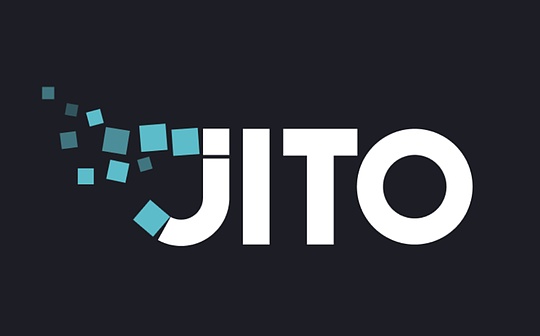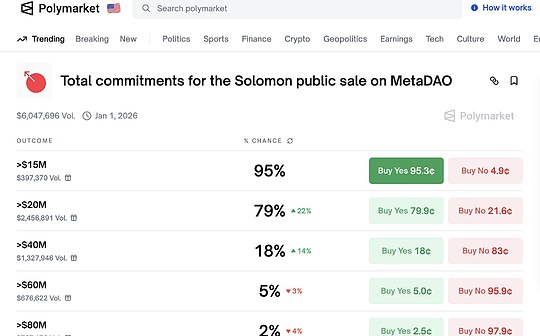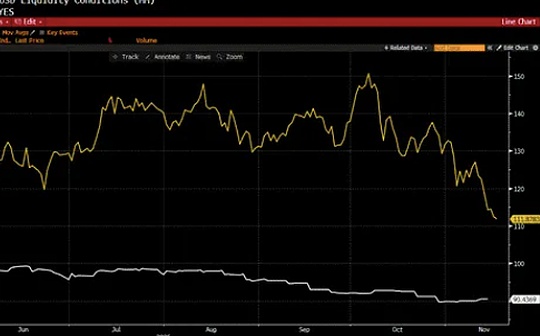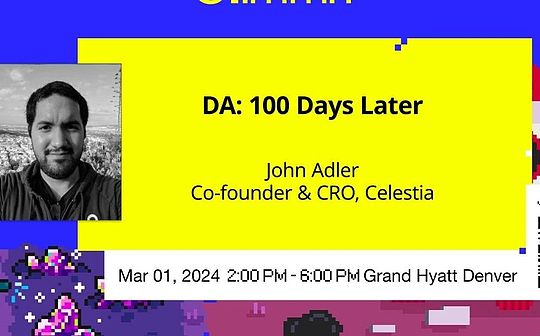
IOSG Ventures’ 11th Friends Event “Restaking Summit” recently ended successfully in Denver.The theme of this event covers current hot topics such as DA, Staking/Restaking, AVS, Bitcoin Rollup, Coprocessor, etc. It has set up 4 Talks, 5 Panels, and a fireside chat, which attracted 1,862 participants to register, and a total of 1,862 participants have been registered.2000+ live participants.We will sort out and release the content of the event’s specific speeches and roundtable discussions one after another, so stay tuned.
The following content is a keynote speech on DA: 100 Days Later brought by Celestia founder and CRO John Adler, welcome to read!
DA: 100 Days Later
John Adler, Co-founder, and CRO from Celestia
Hello everyone.My name is John.I am the Co-founder of Celestia and the CRO of Celestia Labs.I mainly work in Protocol Research and manage the engineering team in development.Today, I want to talk about the first 100 days after Celestia’s launch, or more specifically, 122 days after Celestia’s launch, and how the emergence of scalable data availability makes applications and developers a difference.
The Celestia blockchain was launched on October 31, 2023, which was 122 days ago, if I remember correctly.Here is a screenshot of a block browser, you can see the first block created.
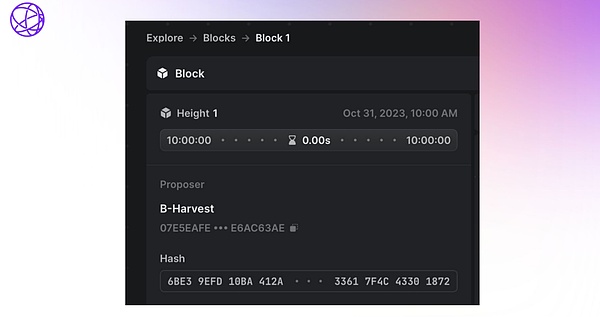
Since then, about 1 million blocks have been created, and about 4.5 GB of Data Blob data has been published to Celestia.If you try to put 4.5 GB of Data Blob data on Ethereum’s CALLDATA for the same time, that would be very expensive.So, what kind of throughput does the first DA centralized blockchain launched by Celestia bring to us?Celestia is one of many on Restaking Summit.There are others.I don’t want to discuss DA blockchain, but we can discuss the DA mechanisms under development, one of which is EigenLayer’s EigenDA, which, as far as I understand, can provide similar throughput.
But it is important to compare with what is already there.So, if you look at Ethereum’s CALLDATA, the average throughput of the Ethereum block is about 10 to 15kb per second, which is like dialing speed, right?The dialing speed is 56kb, divided by 8, which is the same order of magnitude as the dial-up Internet, which is actually not much.Celestia supports 8MB every 12 seconds, which is approximately 670kb per second throughput.The relative difference between the two is shown on this chart, you can see.You can hardly see CALLDATA.
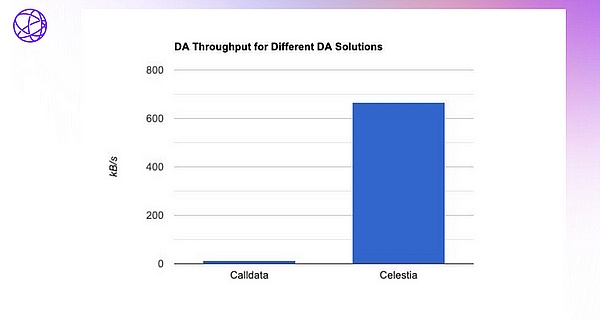 So the launch and availability of highly scalable DA protocols is the broadband moment for cryptocurrencies, right?Just like the internet upgraded from dial-up to broadband, it brought us a range of applications that were not possible before.For example, streaming media, uploading videos, social media sites, delivering pictures, music streaming, content sharing, and more.All of this is not impossible to achieve on dialing, but it can be very difficult.The previous slide discussed throughput, but specifically, what does throughput bring to you?Well, among other things, it can offer you something cheaper, it can offer you something else, of course, the cost depends on the market price and so on.But as a general rule, it can provide you with a substantial reduction in fees.
So the launch and availability of highly scalable DA protocols is the broadband moment for cryptocurrencies, right?Just like the internet upgraded from dial-up to broadband, it brought us a range of applications that were not possible before.For example, streaming media, uploading videos, social media sites, delivering pictures, music streaming, content sharing, and more.All of this is not impossible to achieve on dialing, but it can be very difficult.The previous slide discussed throughput, but specifically, what does throughput bring to you?Well, among other things, it can offer you something cheaper, it can offer you something else, of course, the cost depends on the market price and so on.But as a general rule, it can provide you with a substantial reduction in fees.
That’s why many people are excited about projects like EIP-4844, EigenDA, and Celestia, as they unlock many applications that were previously unavailable due to their current expenses.For example, Manta Network, launched around December 2023, or Celestia was applied around December 2023, if that’s right.Since then, they calculated that by using Celestia instead of Ethereum CALLDATA, they saved nearly $2 million in Gas fee.This is an agreement that has only been online for more than two months.Now, imagine if you extend this money-saving way to using more protocols, and more Rollups, then Gas fee saves a huge amount of money.
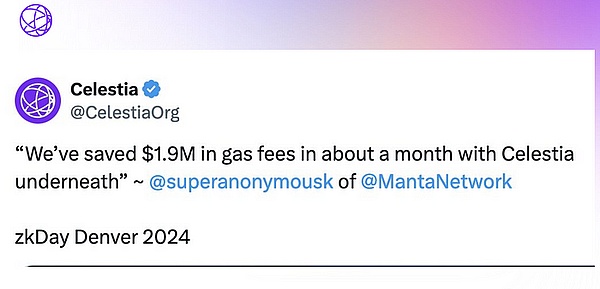
So, what else have we seen after the first 100 or 122 days of Celestia launch?Here is a screenshot of today’s “L2 Beats”, showing a lot of Layer 2 protocols on Ethereum.There are many protocols such as Layer 2 and Rollups that are not on Ethereum.Some are Celestia native, or native to other blockchains, such as Solana. I don’t know if Solana has any Layer 2, but you can see here, these purple, 8 out of 48, 8 out of 40 or 41, currently uncensored, are using Celestia for DA, and more on the way.
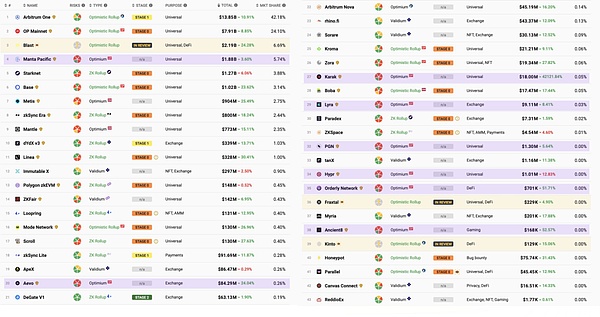
Here is a Tab, which is a screenshot of the upcoming Layer 2. Many of them are using our Celestia to DA. We also see some things that people have been talking about for a long time but have not been deployed for a long time.One is the lack of scalable DA solutions. Without scalable DA solutions, large amounts of execution will not be much value, because execution is not a bottleneck, and the cost of DA is.But since then, we have seen Layer 3 deploy and production.For example, in the Arbitrum ecosystem there is Arbitrum Orbit, and Optimism hyperchain.
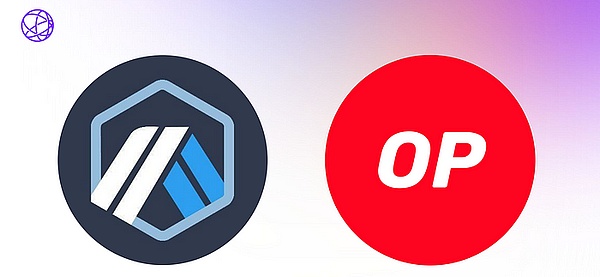
Of course, there are also teams that are developing their Layer 3 solutions, which are in progress.For example, zkSync Hyperchains, which I think they discussed a few years ago, are still in progress.And Starknet, I forgot what it is called, but Starknet is also working on Layer 3.The Layer 3 application chain is located on the public Starknet chain.Layer 3 has this fractal expansion that has been talked about for a long time.However, since DAs are the bottleneck of execution, they were not very needed before.
Now that you have scalable DA solutions, you’ll see things like Arbitrum Orbit and Optimism Superchain go into production, and people can start a lot of Rollups with a variety of different good features.You can share bridges, share liquidity, share common community values and governance, and more.Until Celestia launched, that wasn’t really a big deal.Needless to say, this is just the first 100 days, and with the introduction of additional data availability layers and future developments, these things that were not possible before will only accelerate.
There are also launches of RaaS or Rollup as service providers.For example, this is a screenshot of Conduit, which I remember was released publicly on February 21 this year.
So it was almost two weeks ago, and not even two weeks ago.It actually allows you to deploy a Rollup and select the stack you want to use, such as OP stack, Superchain, or Arbitrum Orbit.Select its chain.Therefore, it can be Ethereum or something.So this will start a Layer 2, or it can be, for example, Base.So this will be based on Layer 3 on Base.Of course, choose your data availability layer.This kind of stuff is like those modular stack Layer3s, and everyone is talking about it, right?There is an execution layer, a settlement layer, and a data availability layer.
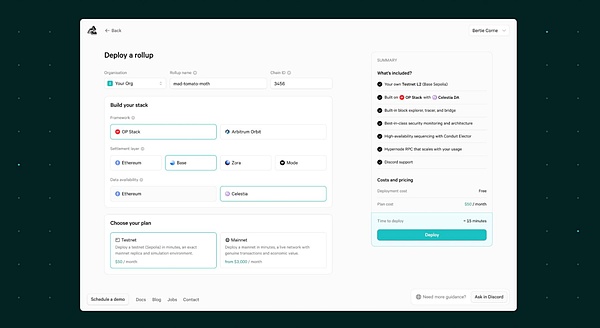
You can choose to use one of these stacks to deploy your Rollup.Click a few buttons, click Deploy, and then your Rollup is deployed.As easy as deploying smart contracts, or in this case it may even be easier.This kind of thing didn’t exist at all before modular blockchains.Right?Before this, if you want to deploy your own blockchain, you have to do a lot of work, modify various codes that are not suitable for being forked, etc.
Of course, then you have to start all the peer networks yourself and do all of that, start the validator collection yourself and so on, and you only need to do all of this before you even start building the community, bringing in applications, etc.In this case, these Rollups are available as service providers.You can deploy Rollup by clicking a few buttons.
OK, that’s what we’ve seen over the past 100 days.What’s next?We’re not over yet, of course.We need more throughput, but we are afraid that there will be no more throughput.Therefore, our goal is to blocks of at least 1GB, which will provide about 100MB per second throughput, which is another order of magnitude increase.

The launch of Celestia was two orders of magnitude more than it had happened at the time.We hope to add two orders of magnitude.This will allow you to have a billion users and a million Rollups.In addition, improving the security of data availability sampling is the security basis of all these data availability protocols, including Celestia, EigenDA, Avail, and even Ethereum Danksharding, which is the security basis.So we are developing what we have always called level-5 light node security, which includes sampling until anonymous data availability.Finally, this protocol expands with the increase in the number of users running light nodes.
Users contribute to security in a way that traditional protocols cannot do.So you can run light nodes anywhere, for example, even light nodes in your browser, so you can open your phone, open your browser, run light nodes on any device you want, just very lowResource requirements.This is something that many agreements do not have no emphasis.They say it’s just to trust most validators, but it’s not, you should run light nodes.You should accept fraud or proof of validity to ensure that the verifier is honest and requires very little resources.
OK, last but not least, a call to action, to build anything under Celestia.The advantage of these data availability layers is that they have no opinions.
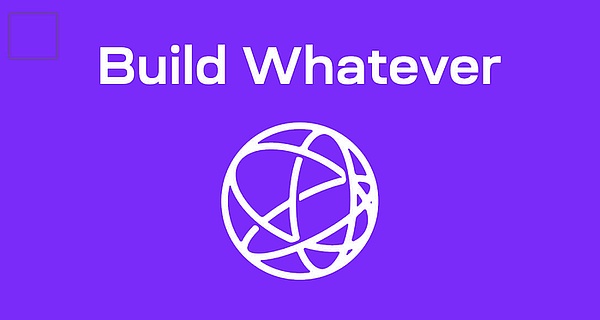
Due to their flexibility, they don’t specify or limit what you can build on it.So if you want to have different checkout layers, if you want to have different execution layers, or even something that doesn’t exist today, you can build it.And you can build it with the support of Celestia.
OK, that’s all for today.Thank you everyone, and thank you IOSG Ventures for organizing this Restaking Summit event for everyone.

